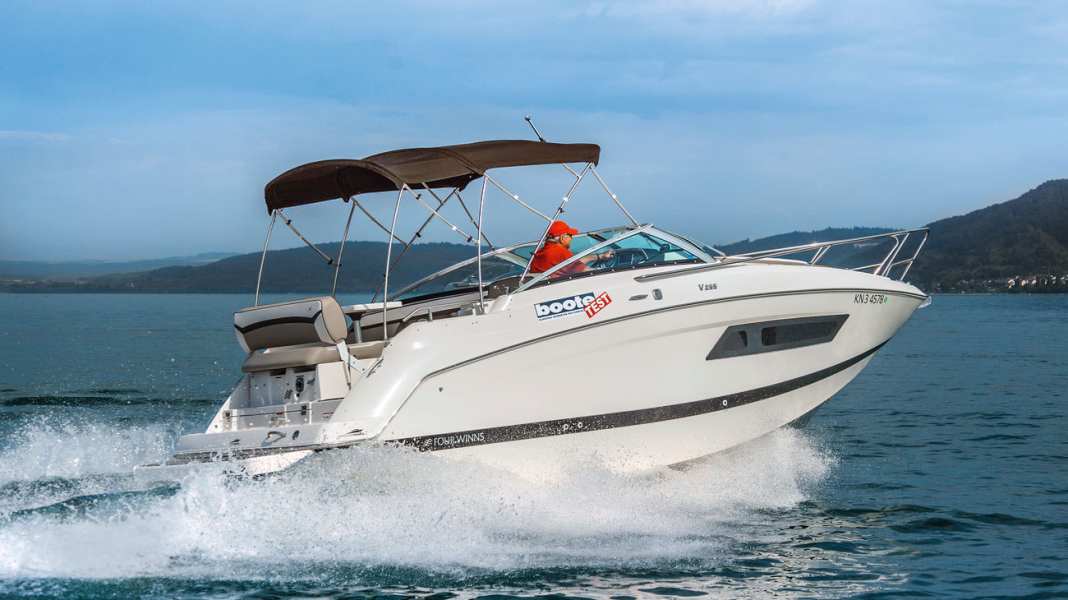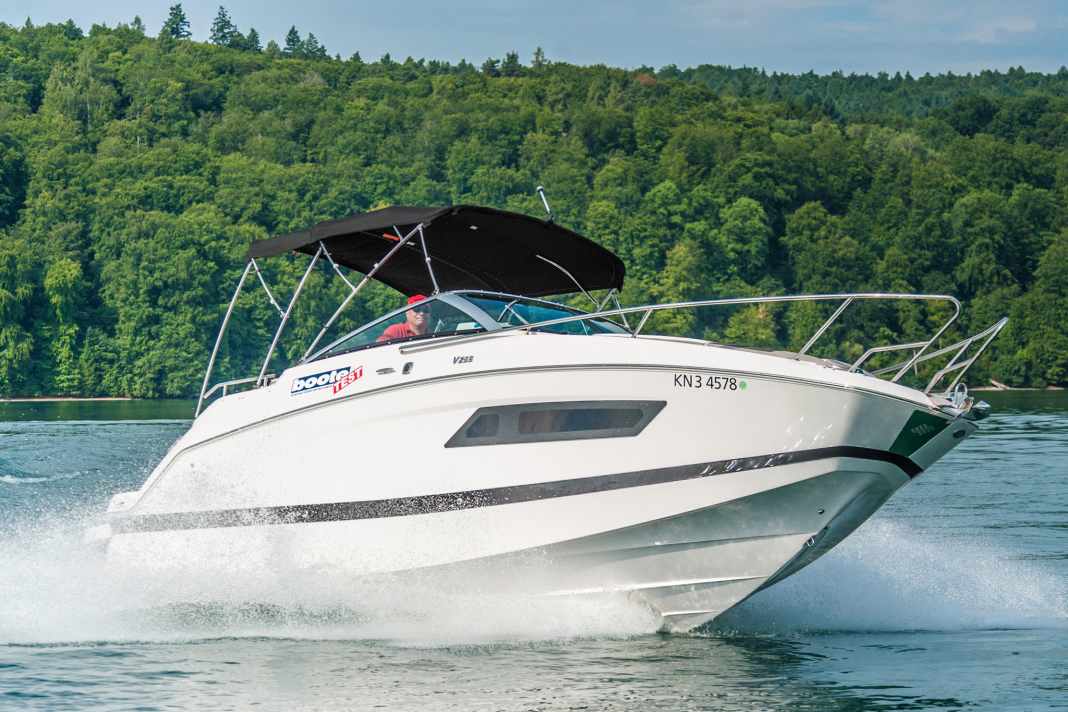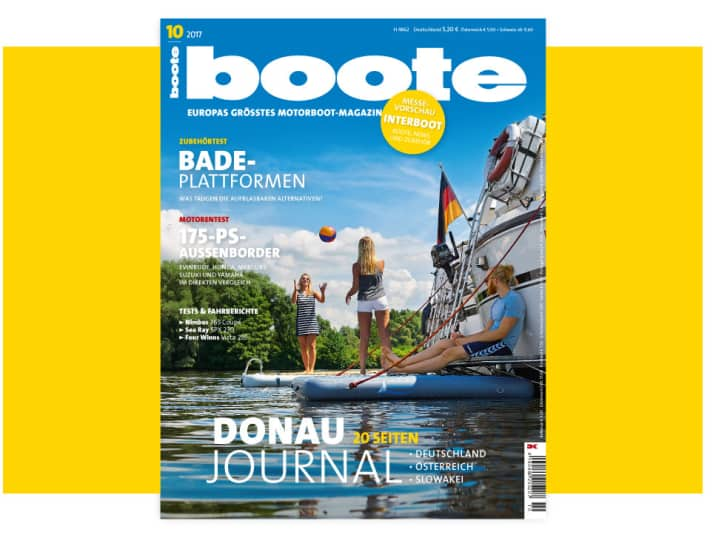
Whether a boat can be trailered depends on its weight and dimensions. In the case of cabin cruisers, agood compromise between these requirements and sufficient space below deck. The dealer calculated a weight of 2800 kg for our well-equipped test boat.This is still manageable with a 3.5-tonne trailer and vehicles such as SUVs and the like.
Our Four Winns V 255 istypical cruiser divided. There is a seating area at the front which can be converted into a double berth.






However, this is not a classic V-berth, but rather aAsymmetrical designwhich has a width of around 2.00 metres in the entrance area and narrows to around 1.35 metres towards the bow (see the technical data).
The dimensions of the underfloor berth are clearer: at 2.10 m x 1.45 m, everyone can imagine how much space there is for sleeping.
Here, the entrance between the companionway stairs and the pantry block is somewhat narrower,but it is quite manageable for adults. The clear height between the mattress and the ceiling is around 0.60 m at the foot end and 0.97 m at the head end - usually quite sufficient.
There are three open cupboard compartments at the rear. The pantry block (with refrigerator) offers storage options for kitchen utensils in side compartments, behind theWorktop with integrated sink and in a wall unit, in which aMicrowave is built in. WhoeverHotplate The advantage of this is that the smell of food (especially spicy food) is kept out of the living area.
On the starboard side, the designer has accommodated the wet room with a headroom of 1.81 metres. The space is well organised and has everything you need with a washbasin, electric toilet with waste-holding tank, pull-out shower hose and floor drain. A rear shower (included in the 230 V package together with the boiler) ensures that you can quickly rinse off after swimming.
You pay extra for the extended bathing platform installed on our test boat and the grey softshell covering. The accompanying ladder is easy to use from the water and extends deep into the water. A door is installed at the stern passage from the platform to the cockpit, which provides safety for smaller children in particular. In the cockpit, we find a variety of lounger/seat combinations as well as a wet bar with the aforementioned hotplate. If the sun loungers in the cockpit are not enough, you can move to the large foredeck cushion.
Access to the foredeck is via the centre passageway with sufficiently wide steps with an anti-slip structure. The grab handle and window frame, which is rounded at the corners to protect against injury, are ideal for holding on to. In rough seas, it is best to crawl from there on all fours to the railing in order to reach the self-draining anchor locker safely, for example. In terms of safety equipment, the fire extinguishing system is impressive, but the bilge system lacks a hand pump that also works in the event of a power failure.
Of course, the issue of safety also concerns the sailing characteristics, especially fast manoeuvres and rough water sailing. We were only able to judge the latter on Lake Constance on the basis of waves from the White Fleet and sports boats. The hull skips these easily and dryly. During fast manoeuvres such as tight circles, the boat sits firmly on its "cheek", makes tight turns without hooking or rocking and brakes automatically.
The duoprop always remains positive, and when steering out with the smooth power steering, the V6-280 from Volvo Penta immediately accelerates the Four Winns again. On slalom courses, the V 255 swings back and forth quite a bit, which is not unusual due to its high centre of gravity and seating position. From up there, the driver has a good view through the safety glass windscreen.
When the boat switches from displacement to planing speed at 2200 rpm, the bow rises and lowers again automatically at 3800 rpm. Sufficient visibility is maintained. The trim tabs are used to improve this and the boat's position at low planing speeds. At faster planing speeds, the flaps are raised and the test boat is brought into the optimum position with the power trim. At full throttle at almost 35 kn and an optimum 5800 rpm, this is about ½ on the trim indicator. At 10 knots less, the motor-boat combination glides most economically. At the same time, 1.62 l/sm runs through the fuel line, and with the 265-litre tank, the range is an acceptable 140 nm plus 15% reserve.
On slow courses, you have to let the hull level out and only correct a little from time to time. During mooring manoeuvres, the Four Winns reacts with a delay of around 4 seconds to the steering change and almost turns on the plate. Good characteristics for safe and precise manoeuvring; however, if there is wind, the bow thruster, which is available at extra cost, is recommended. On our test boat, this is controlled via a lever next to the height-adjustable steering wheel. The helm position is ergonomically arranged and everything is easy to operate. We noticed the usual reflections on the instruments, and the directly adjacent white stripe is reflected in the windscreen.
The technician has to really get to grips with it when lifting the GRP engine compartment lid with upholstery and conversion mechanism for the backrest. This adds up to a few kilograms. Underneath, the engine, which is easily accessible from all sides, stands on solid foundations. To keep the sound pressure in check, Four Winns uses self-extinguishing insulation, which also dampens the sound sufficiently. The installations show a good US-American standard, the same applies to the entire boat processing.
The windscreen wiper and navigation lights with an approval number from an EU testing institute are missing from the standard equipment.
CONCLUSION
The Four Winns Vista 255 is a great cruising boat for a family of four who also want to trailer; according to the boatyard, this is still possible with a 3.5 tonne trailer. The V6-280 engine has enough power to accelerate the boat quickly and, with its catalytic converter, is also approved for our test area of Lake Constance.
This test appeared in BOOTE issue 10/2017


